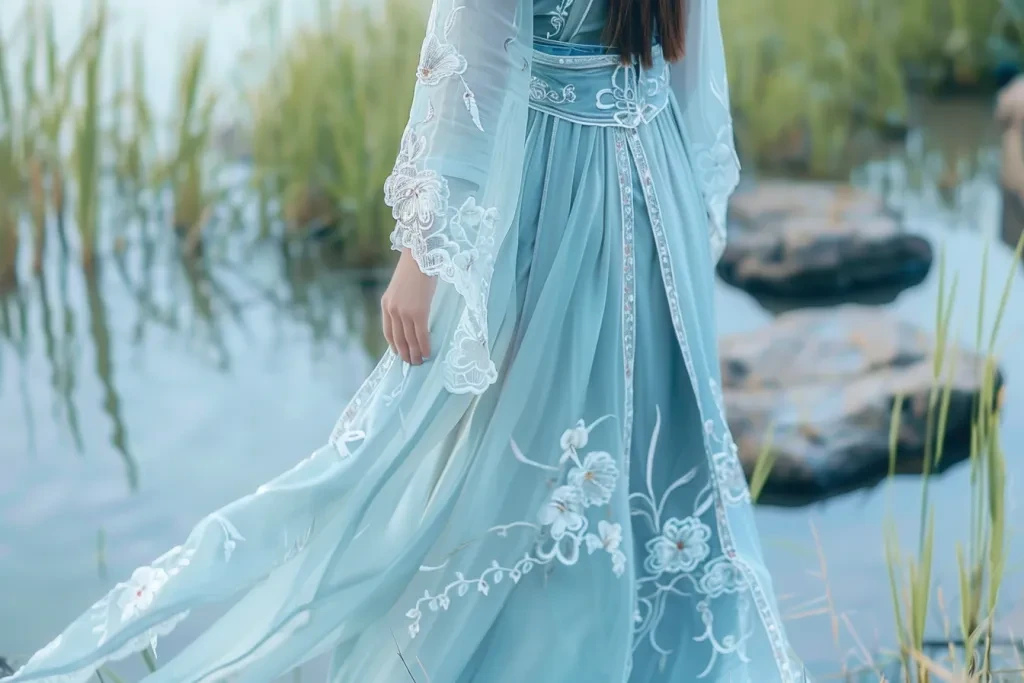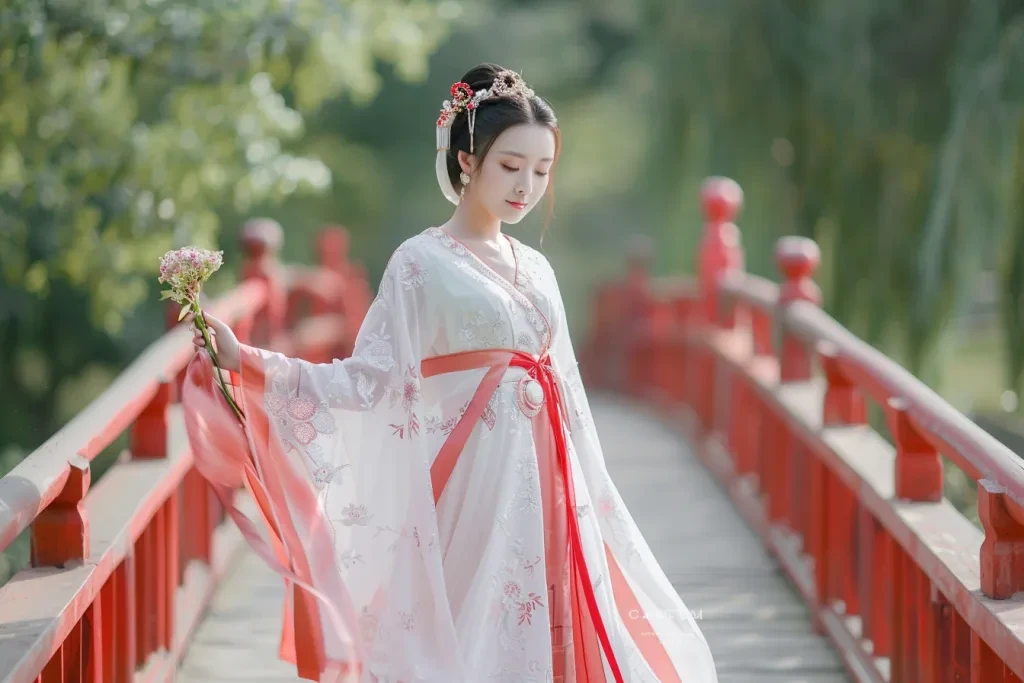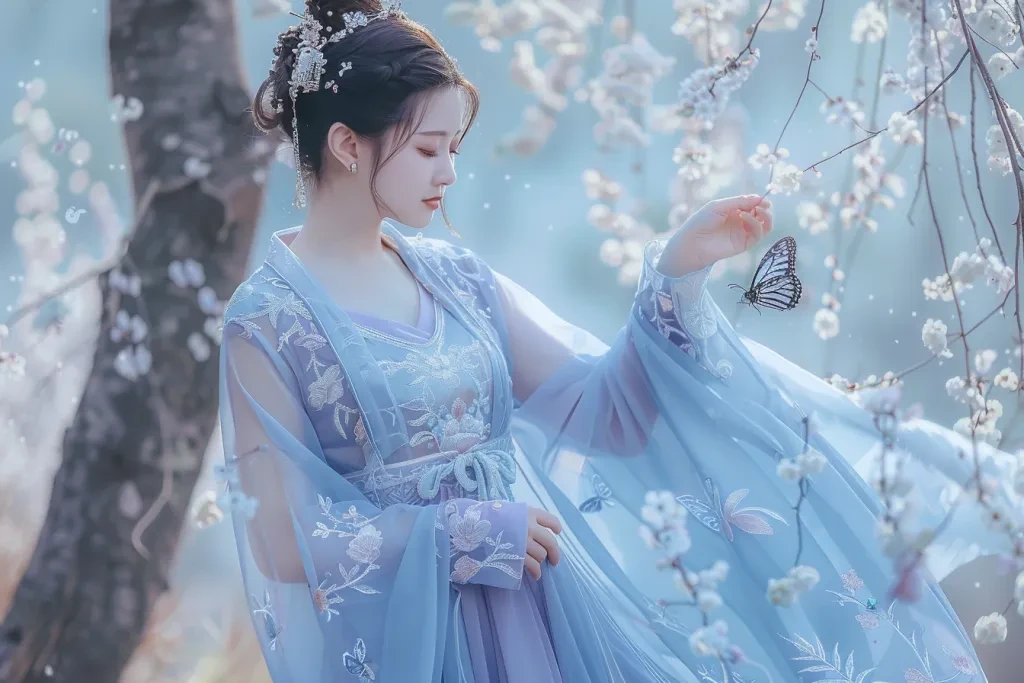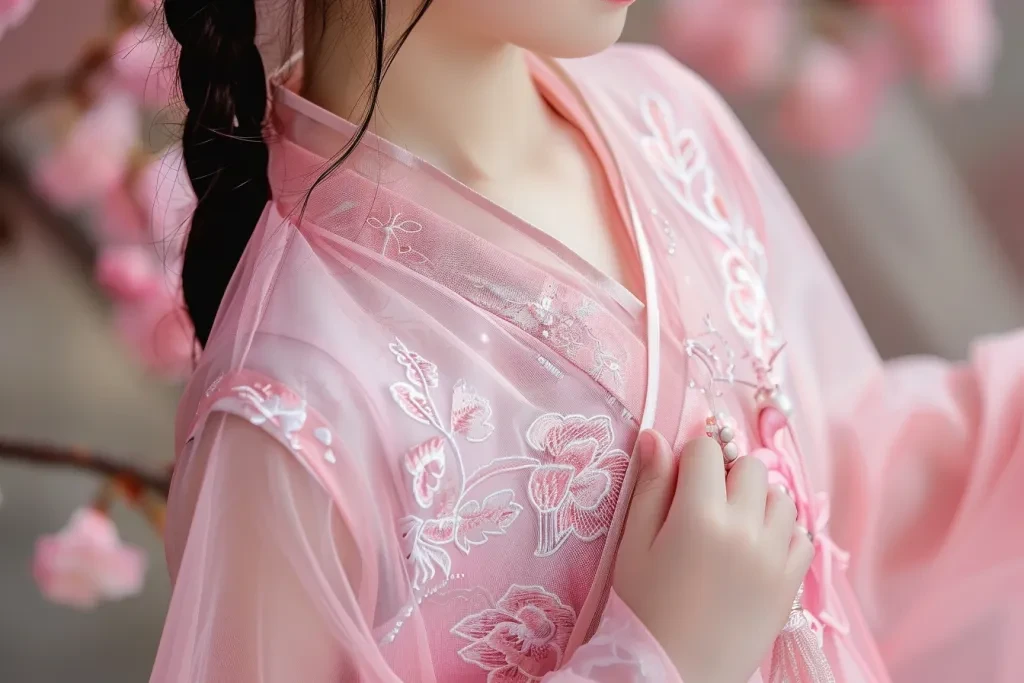Hanfu, the traditional attire of the Han Chinese, is experiencing a remarkable resurgence in the global market. This ancient garment, with its rich history and cultural significance, is captivating fashion enthusiasts worldwide. In this article, we delve into the rising popularity of Hanfu, exploring its historical roots, current market trends, and the key demographics fueling its growth.
Table of Contents:
– The Rising Popularity of Hanfu in the Global Market
– Diverse Styles and Types of Hanfu
– The Art of Hanfu Design and Aesthetics
– Customization and Personalization in Hanfu
– The Future of Hanfu in the Apparel Industry
The Rising Popularity of Hanfu in the Global Market

A Brief History of Hanfu
Hanfu, which translates to “Han clothing,” dates back over 4,000 years and has been a significant part of Chinese culture throughout various dynasties. The garment is characterized by its flowing robes, wide sleeves, and intricate designs, often reflecting the social status and cultural values of the wearer. Historically, Hanfu was worn by the Han Chinese, the largest ethnic group in China, and it played a crucial role in ceremonies, festivals, and daily life.
The decline of Hanfu began during the Qing Dynasty (1644-1912), when the ruling Manchu imposed their own style of dress on the Han Chinese. However, the 21st century has seen a revival of interest in Hanfu, driven by a growing appreciation for traditional culture and heritage among younger generations.
Current Market Trends and Consumer Preferences
The global market for Hanfu is experiencing significant growth, with increasing demand from both domestic and international consumers. According to WGSN, the Hanfu market is expected to grow at a compound annual growth rate (CAGR) of 15% from 2023 to 2028. This growth is fueled by several factors, including the rise of nostalgia marketing, the influence of social media, and the desire for unique and culturally significant fashion.
Nostalgia marketing plays a crucial role in the resurgence of Hanfu. Brands are tapping into the emotional connection that consumers have with traditional culture, particularly during festive periods. For example, multi-label retailer Labelhood’s Family Portrait campaign for Lunar New Year 2024 captured life in small towns and village banquets across China, resonating with consumers’ longing for simpler times.
Social media platforms like Xiaohongshu and Weibo are also instrumental in popularizing Hanfu. Hashtags such as #HanfuRevival and #HanfuDaily have garnered millions of views, with influencers and celebrities showcasing their Hanfu outfits and encouraging their followers to embrace this traditional attire. According to WGSN, Xiaohongshu’s Foodie Marathon campaign, which celebrated Shanghai’s culinary scene, earned 7.2 million views, highlighting the platform’s power in driving cultural trends.
Key Markets and Demographics
The primary markets for Hanfu are China, the United States, and Southeast Asia. In China, the Hanfu movement is particularly strong among Millennials and Gen Z, who are seeking ways to reconnect with their cultural heritage. According to WGSN, these younger consumers are transitioning from passive participants to active organizers of family festivities and social gatherings, using Hanfu as a tool for self-expression and cultural unity.
In the United States, the growing interest in Hanfu is driven by the increasing popularity of Chinese culture and fashion. Events like Pulse Events’ Lunar New Year party in Brooklyn, which merged electronic dance music with traditional activities, have introduced Hanfu to a broader audience. Additionally, the rise of e-commerce platforms has made it easier for international consumers to purchase Hanfu, further expanding its reach.
Southeast Asia is another key market for Hanfu, with countries like Malaysia, Singapore, and Thailand showing a growing interest in traditional Chinese attire. The region’s diverse cultural landscape and strong Chinese communities provide a fertile ground for the Hanfu movement to flourish.
Diverse Styles and Types of Hanfu

Traditional vs. Modern Hanfu
Hanfu, the traditional clothing of the Han Chinese, has seen a resurgence in popularity in recent years. This resurgence has brought about a fascinating blend of traditional and modern styles. Traditional Hanfu is characterized by its flowing robes, wide sleeves, and intricate designs that reflect the rich cultural heritage of China. These garments are often made from luxurious fabrics such as silk and adorned with elaborate embroidery and patterns that have been passed down through generations.
In contrast, modern Hanfu incorporates contemporary fashion elements while maintaining the essence of traditional designs. Modern Hanfu often features simplified silhouettes, more practical fabrics, and a fusion of traditional and modern aesthetics. This blend allows for greater versatility, making Hanfu suitable for both everyday wear and special occasions. According to the Design Capsule: Women’s Modest Meta-Classical S/S 25, the trend of reimagining wardrobe essentials through a romantic lens, with three-dimensional embellishment and opulent materials, aligns well with the modern Hanfu movement.
Popular Styles and Their Unique Features
Several popular styles of Hanfu have emerged, each with its unique features. The Ruqun, for example, is a two-piece outfit consisting of a blouse and a long skirt. It is known for its elegant and flowing lines, making it a favorite for formal occasions. The Shenyi, another popular style, is a one-piece garment that wraps around the body and is secured with a sash. It is often worn for its simplicity and comfort.
The Qixiong Ruqun, characterized by its high-waisted skirt, has gained popularity for its flattering silhouette. This style often features intricate embroidery and vibrant colors, making it a standout choice for festivals and celebrations. The Beizi, a long, loose outer garment, is another versatile piece that can be worn over other Hanfu styles for added warmth and elegance.
Seasonal Variations in Hanfu Designs
Hanfu designs also vary according to the seasons. In spring and summer, lighter fabrics such as silk and cotton are preferred for their breathability and comfort. These garments often feature floral patterns and pastel colors, reflecting the beauty of nature. The Design Capsule: Women’s Modest Meta-Classical S/S 25 highlights the use of soft pastels and floral jacquards, which are perfect for spring and summer Hanfu.
In autumn and winter, heavier fabrics such as brocade and velvet are used to provide warmth. These garments often feature darker colors and more intricate embroidery, adding a touch of sophistication to the wearer’s ensemble. The use of rich materials and detailed embellishments, as seen in the Naive Opulence jacquards, adds luxury and surface interest to winter Hanfu designs.
The Art of Hanfu Design and Aesthetics

Intricate Patterns and Embroidery
The art of Hanfu design is deeply rooted in its intricate patterns and embroidery. Traditional motifs such as dragons, phoenixes, and floral designs are commonly used, each carrying its symbolic meaning. For instance, dragons symbolize power and strength, while phoenixes represent beauty and grace. These motifs are often embroidered using techniques that have been perfected over centuries, resulting in stunningly detailed and vibrant designs.
Color Palettes and Their Symbolism
Color plays a significant role in Hanfu design, with each color carrying its symbolism. Red, for example, is associated with happiness and prosperity and is often worn during weddings and festivals. Blue symbolizes tranquility and is commonly used in everyday wear. According to the Design Capsule: Women’s Modest Meta-Classical S/S 25, colors such as unbleached cotton, panna cotta, and sage green are popular choices for modern Hanfu, reflecting a blend of tradition and contemporary aesthetics.
The Role of Fabrics and Materials in Hanfu
The choice of fabrics and materials is crucial in Hanfu design. Traditional Hanfu is often made from silk, known for its luxurious feel and elegant drape. Modern Hanfu, however, incorporates a wider range of materials, including cotton, linen, and synthetic fabrics, to enhance comfort and practicality. The use of satin with subtle jacquard or Lurex thread, as suggested in the Design Capsule, adds a touch of sophistication to modern Hanfu, making it suitable for various occasions.
Customization and Personalization in Hanfu

Custom Design Services and Their Growing Demand
The demand for custom design services in Hanfu has grown significantly. Many designers and tailors now offer bespoke Hanfu, allowing customers to choose their fabrics, colors, and embroidery patterns. This trend is driven by a desire for unique and personalized garments that reflect the wearer’s individuality. According to the Design Capsule: Women’s Modest Meta-Classical S/S 25, the trend of designing for repair and resale also aligns with the growing demand for sustainable and customizable fashion.
The Influence of Cultural Heritage on Customization
Cultural heritage plays a vital role in the customization of Hanfu. Many customers seek to incorporate elements of their cultural background into their garments, such as traditional motifs, family crests, or regional embroidery styles. This personalization not only adds sentimental value to the garments but also helps preserve and promote cultural heritage. The influence of cultural heritage on customization is evident in the growing popularity of Hanfu that incorporates historical references and modernizes them with sleek cuts and inventive drapery, as highlighted in the Design Capsule.
The Future of Hanfu in the Apparel Industry

Emerging Trends and Innovations
The future of Hanfu in the apparel industry looks promising, with several emerging trends and innovations. The integration of modern technology in fabric production and design is one such trend. For instance, the use of digital printing allows for more intricate and precise patterns, while advancements in fabric technology enhance the comfort and durability of Hanfu garments. The trend of blending traditional and modern elements, as seen in the Meta-classical trend, is likely to continue, offering consumers a unique and versatile wardrobe option.
The Impact of Social Media and Influencers
Social media and influencers have played a significant role in the resurgence of Hanfu. Platforms such as Instagram, TikTok, and Weibo have become popular spaces for Hanfu enthusiasts to share their outfits, styling tips, and cultural insights. Influencers and fashion bloggers have also contributed to the growing popularity of Hanfu by showcasing its versatility and beauty to a global audience. This trend is expected to continue, further boosting the visibility and appeal of Hanfu in the fashion industry.
Potential for Growth in International Markets
The potential for growth in international markets is another exciting prospect for Hanfu. As more people around the world become interested in Chinese culture and fashion, the demand for Hanfu is likely to increase. International fashion shows, cultural festivals, and online platforms provide opportunities for Hanfu designers to reach a broader audience. The trend of modernizing historical references, as seen in the Meta-classical trend, makes Hanfu more accessible and appealing to international consumers.
Conclusion
The resurgence of Hanfu in the apparel industry is a testament to the enduring appeal of traditional Chinese fashion. With its diverse styles, intricate designs, and cultural significance, Hanfu offers a unique blend of tradition and modernity. As customization and personalization become increasingly important, and with the influence of social media and emerging trends, the future of Hanfu looks bright. As we look to the future, Hanfu is poised to continue its journey as a symbol of cultural heritage and contemporary fashion.





 বাংলা
বাংলা Nederlands
Nederlands English
English Français
Français Deutsch
Deutsch हिन्दी
हिन्दी Bahasa Indonesia
Bahasa Indonesia Italiano
Italiano 日本語
日本語 한국어
한국어 Bahasa Melayu
Bahasa Melayu മലയാളം
മലയാളം پښتو
پښتو فارسی
فارسی Polski
Polski Português
Português Русский
Русский Español
Español Kiswahili
Kiswahili ไทย
ไทย Türkçe
Türkçe اردو
اردو Tiếng Việt
Tiếng Việt isiXhosa
isiXhosa Zulu
Zulu